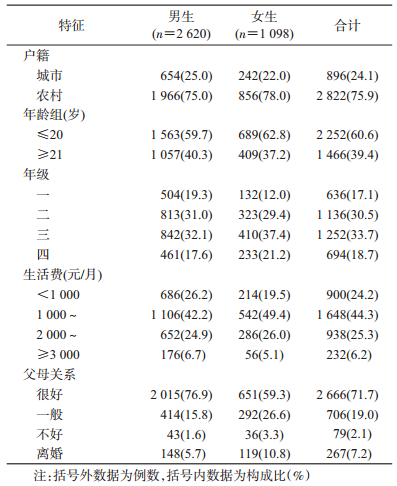文章信息
- 姜婷婷, 陈琳, 周欣, 王憓, 陈婉君, 陈卫永, 吴瑕, 金骆彬, 朱红薇, 马瞧勤.
- Jiang Tingting, Chen Lin, Zhou Xin, Wang Hui, Chen Wanjun, Chen Weiyong, Wu Xia, Jin Luobin, Zhu Hongwei, Ma Qiaoqin
- 浙江省大学生拒绝无保护性行为的信心评价及其相关因素分析
- Evaluation on the confidence of refusing unprotected sex behavior and related factors among college students in Zhejiang province
- 中华流行病学杂志, 2019, 40(12): 1601-1605
- Chinese Journal of Epidemiology, 2019, 40(12): 1601-1605
- http://dx.doi.org/10.3760/cma.j.issn.0254-6450.2019.12.018
-
文章历史
收稿日期: 2019-06-03
2. 宁波职业技术学院 315000;
3. 绍兴文理学院 321000;
4. 金华职业技术学院 321000
2. Ningbo Polytechnic, Ningbo 315000, China;
3. Shaoxing University, Shaoxing 321000, China;
4. Jinhua Polytechnic, Jinhua 321000, China
近年来,青年学生作为我国重点关注人群,HIV感染人数呈上升趋势[1]。中国CDC的统计数据显示,2011-2015年,大学生新报告HIV感染者以每年35%的速度增长,其中男生占80%[2]。由于性健康教育的缺乏,大学生更容易发生高危性行为[3]。因此,减少该人群无保护性行为,降低新发感染是当代青年学生艾滋病防治工作的重点。目前,正确使用安全套是预防性接触传播艾滋病的主要方法之一[4],拒绝无保护性行为的安全套使用信心被认为可以有效促进安全套使用[5-6]。本研究通过专题调查了解大学生人群中拒绝无保护性行为的信心,为高校艾滋病制定针对性的干预措施提供建议。
对象与方法1.研究对象:纳入标准:①一至四年级的在校大学生;②自我报告发生过性行为;③知情同意。本研究通过浙江省CDC伦理委员会审查(批号:2018-36)。
2.研究方法:采用横断面调查的方法。根据横断面调查样本量计算公式,结合国内大学生性行为发生率10%~20%,估算样本量为683~1 537人。
(1)研究现场:浙江省13所高校(本科院校8所,专科院校5所),其中杭州市3所,其余10个地市各1所。高校的选择由当地CDC结合高校意愿决定。
(2)抽样方法和样本量:采用分层整群抽样方法,每所高校随机抽取3个院系,按照一至四年级分为4层,每层采用随机数字法抽取班级,共1 241个,本科院校完成2 400人,大专院校完成1 800人,估计样本量为4 200人。
(3)问卷调查:采用浙江省CDC设计的“浙江省高校学生艾滋病检测知识和行为调查”网络问卷,包括社会人口学特征、性态度和性行为,学校开展的相关宣传教育,安全套使用信心等内容。老师负责组织学生集中开展调查,学生用手机扫描二维码完成问卷,该方法在一定程度上避免了学生因担心隐私泄露而导致的信息偏倚。
(4)相关定义:以“如果性行为时未携带安全套或您的性伴不同意使用安全套,您有信心不发生性行为吗?”评价大学生拒绝无保护性行为的信心;①拒绝无保护性行为:在与性伴发生性行为时,如果未携带安全套或者性伴不同意使用安全套,则拒绝发生性行为;②是否有信心拒绝无保护性行为为5个等级:非常有信心、很有信心、有信心、没有信心和非常没有信心。本研究中,将回答为非常有信心、很有信心及有信心定义为有信心,将回答为没有信心和非常没有信心定义为没有信心。
3.统计学分析:采用问卷星TM和Excel 2010软件收集和整理数据,利用SPSS 19.0软件进行统计学分析。计数资料采用频数(百分比)表示,组间差异比较采用χ2检验、单因素分析筛选自变量(筛选标准为P<0.2),采用多因素logistic回归模型分析大学生有信心拒绝无保护性行为的相关因素。以P<0.05差异有统计学意义。
结果1.人口学特征:共纳入研究对象3 718人,男生2 620人,女生1 098人。年龄(20.17±1.38)岁,其中≤20岁占60.6%,户籍以农村为主(75.9%),年级以大二和大三为主(64.2%),月均生活费以1 000~3 000元为主(69.6%),父母关系很好比例最高(2 666,71.7%)。经χ2检验,仅女生在户籍、年龄方面是否有信心拒绝无保护性行为差异有统计学意义(χ2=5.618、7.961,均P<0.05);男、女生在年级、生活费、家庭关系等方面差异有统计学意义(均P<0.05)(表 1)。
2.有信心拒绝无保护性行为的单因素分析:如果性行为时未携带安全套或者性伴不同意使用安全套时,74.9%的男生和77.9%的女生有信心不发生性行为,经χ2检验,不同性别的大学生在拒绝无保护性行为的差异无统计学意义(P>0.05);将性态度、不同类型性行为、接受艾滋病宣传教育和检测、HIV感染风险评估等变量与不同性别大学生拒绝无保护性行为信心进行χ2分析,结果显示:男生中,不接受临时性行为、男男性行为的比例较高,有信心拒绝无保护性行为的差异有统计学意义(均P<0.05);最近1年发生过固定性行为、临时性行为与商业性行为,接受过学校艾滋病专题讲座、通过学校网络了解过艾滋病信息、接受过学校开展的艾滋病检测宣传以及风险评估,知道学校有无自我检测试剂售卖或领取,有信心拒绝无保护性行为信心的差异有统计学意义(均P<0.05)。女生中,城市户籍、年龄≥21岁、接受过学校开展的风险评估,有信心拒绝无保护性行为的差异有统计学意义(均P<0.05)。见表 2。
3.有信心拒绝无保护性行为的多因素分析:多因素logistic回归分析结果显示,男生的相关因素包括不接受临时性行为(与接受的相比,OR=2.247,95%CI:1.828~2.762)、不接受男男性行为(与接受的相比,OR=1.810,95%CI:1.302~2.516)、最近1年发生临时性行为(与未发生的相比,OR=1.345,95%CI:1.051~1.721)、知道学校有HIV自检试剂(与不知道的相比,OR=1.381,95%CI:1.011~1.887)、接受过学校开展HIV感染风险自我评估(与未接受的相比,OR=1.707,95%CI:1.374~2.121);女生的相关因素包括来自城市(与来自农村的相比,OR=1.816,95%CI:1.225~2.693)、≥21岁(与≤20岁的相比,OR=1.469,95%CI:1.075~2.007)、接受过学校开展HIV感染风险自我评估(与未接受的相比,OR=1.597,95%CI:1.093~2.333)。见表 2。
讨论拒绝无保护性行为作为促进安全套使用策略之一,可以提高安全套使用,从而预防HIV/STD[7]。本研究发现,有信心拒绝无保护性行为的男生为74.9%、女生为77.9%。
临时性行为和同性性行为等是感染HIV危险因素[1],本研究发现,不接受临时性行为、不接受男男性行为的男生中,更有信心拒绝无保护性行为。说明安全性行为的理念能提高大学生自我保护意识。当代大学生性观念日趋开放,正确的性观念和性道德尚未完全建立,导致高危性行为的发生率上升[8-9],造成性病感染和意外怀孕等现象发生。本研究发现,有51.5%的男生和19.7%的女生接受临时性行为,11.7%的男生接受男男性行为。应加强安全性行为的教育,减少危险行为。另外,最近1年发生临时性行为的男生中,更有信心拒绝无保护性行为。国外相关研究表明[10],与固定性伴的性行为相比,男性发生临时性行为,更易于使用安全套。男性与临时性伴坚持使用安全套的可能性是固定性伴的3~4倍,说明男性对发生临时性行为有较高的风险意识[11]。
由于怀孕、社会期望等压力影响,女性在性观念和性行为上更为保守和谨慎,更易于拒绝无保护性行为,尤其临时性行为时[12]。本研究发现,来自城市、≥21岁的女生更有信心拒绝无保护性行为。既往研究也发现,低年龄组学生更容易发生高危性行为[13]。应重点关注来自农村和≤20岁的女生。
本研究发现,接受过学校开展HIV感染风险自我评估的大学生,更有信心拒绝无保护性行为。既往研究也指出,提高HIV感染风险预测水平可以改变其危险性行为[14],有感染风险意识的大学生更愿意接受HIV检测[15]。高校应考虑将HIV感染风险评估纳入到大学生艾滋病宣传教育工作中,提高其自我保护意识,必要时及时进行HIV检测。
本研究存在不足,横断面调查无法判定因果关系;未涉及如何使用安全套或拒绝无保护性行为的有效沟通策略和技能[16],需进一步做好高校艾滋病健康教育的实践性研究。
综上所述,男生和女生拒绝无保护性行为的信心均较高。有信心拒绝无保护性行为的保护因素,男生为不接受临时性行为、不接受男男性行为、接受过学校开展HIV感染风险自我评估、知道学校有HIV自检试剂、最近1年发生临时性行为;女生为来自城市、≥21岁、接受过学校开展HIV感染风险自我评估。高校应加强大学生性健康教育,减少无保护性行为,推广HIV感染风险自我评估。
利益冲突 所有作者均声明不存在利益冲突
| [1] |
吴尊友. 我国艾滋病经性传播新特征与防治面临的挑战[J]. 中华流行病学杂志, 2018, 39(6): 707-709. Wu ZY. Characteristics of HIV sexually transmission and challenges for controlling the epidemic in China[J]. Chin J Epidemiol, 2018, 39(6): 707-709. DOI:10.3760/cma.j.issn.0254-6450.2018.06.002 |
| [2] |
Xu HH, Xie JY, Xiao ZZ, et al. Sexual attitudes, sexual behaviors, and use of HIV prevention services among male undergraduate students in Hunan, China:a cross-sectional survey[J]. BMC Public Health, 2019, 19(1): 250. DOI:10.1186/s12889-019-6570-2 |
| [3] |
Sun XY, Liu XN, Shi YH, et al. Determinants of risky sexual behavior and condom use among college students in China[J]. AIDS Care, 2013, 25(6): 775-783. DOI:10.1080/09540121.2012.748875 |
| [4] |
张欣, 娜荷芽, 叶墨, 等. 北京大学生艾滋病相关知识、态度、行为的变化特点及影响因素[J]. 北京大学学报:医学版, 2017, 49(3): 462-468. Zhang X, Na HY, Ye M, et al. Changes of acquired immune deficiency syndrome related knowledge, attitudes, behaviors and their influencing factors among college students in Beijing[J]. J Peking Univ:Health Sci, 2017, 49(3): 462-468. DOI:10.3969/j.issn.1671-167X.2017.03.015 |
| [5] |
Peasant C, Montanaro EA, Kershaw TS, et al. An event-level examination of successful condom negotiation strategies among young women[J]. J Health Psychol, 2019, 24(7): 898-908. DOI:10.1177/1359105317690598 |
| [6] |
Schmid A, Leonard NR, Ritchie AS, et al. Assertive communication in condom negotiation:insights from late adolescent couples' subjective ratings of self and partner[J]. J Adolesc Health, 2015, 57(1): 94-99. DOI:10.1016/j.jadohealth.2015.03.005 |
| [7] |
Tschann JM, Flores E, de Groat CL, et al. Condom negotiation strategies and actual condom use among Latino youth[J]. J Adolesc Health, 2010, 47(3): 254-262. DOI:10.1016/j.jadohealth.2010.01.018 |
| [8] |
Wang HX, Chen B, Xu Y, et al. View changes and educational demands on sexual/reproductive health of students at Shanghai Jiaotong University[J]. Int J Clin Exp Med, 2015, 8(9): 16414-16423. |
| [9] |
Zhang L, Ding XB, Lu RR, et al. Predictors of HIV and syphilis among men who have sex with men in a Chinese metropolitan city:comparison of risks among students and non-students[J]. PLoS One, 2012, 7(5): e37211. DOI:10.1371/journal.pone.0037211 |
| [10] |
Skakoon-Sparling S, Cramer KM. Are we blinded by desire? Relationship motivation and sexual risk-taking intentions during condom negotiation[J]. J Sex Res, 2019. DOI:10.1080/00224499.2019.1579888 |
| [11] |
Foulkes HBS, Pettigrew MM, Livingston KA, et al. Comparison of sexual partnership characteristics and associations with inconsistent condom use among a sample of adolescents and adult women diagnosed with Chlamydia trachomatis[J]. J Women's Health, 2009, 18(3): 393-399. DOI:10.1089/jwh.2008.0840 |
| [12] |
Holland KJ, French SE. Condom negotiation strategy use and effectiveness among college students[J]. J Sex Res, 2012, 49(5): 443-453. DOI:10.1080/00224499.2011.568128 |
| [13] |
葛琳, 崔岩, 李东民, 等. 青年学生2010-2015年艾滋病相关性行为连续横断面研究[J]. 中国学校卫生, 2015, 36(11): 1611-1613, 1617. Ge L, Cui Y, Li DM, et al. Cross-sectional study on AIDS/HIV related sexual behavior among students from 2010-2015[J]. Chin J School Health, 2015, 36(11): 1611-1613, 1617. DOI:10.16835/j.cnki.1000-9817.2015.11.008 |
| [14] |
潘晓红, 丛黎明, 马瞧勤, 等. 大学生自我艾滋病感染危险预测和影响因素研究[J]. 中国学校卫生, 2005, 26(10): 815-817. Pan XH, Cong LM, Ma QQ, et al. Self-perceived Risk of HIV infection and the influencing factors among undergraduates[J]. Chin J School Health, 2005, 26(10): 815-817. DOI:10.3969/j.issn.1000-9817.2005.10.009 |
| [15] |
蒋均, 潘晓红, 杨介者, 等. 浙江省535名有性行为的大学生HIV检测意愿及影响因素研究[J]. 中华流行病学杂志, 2016, 37(10): 1356-1360. Jiang J, Pan XH, Yang JZ, et al. Willingness for HIV test and associated factors among 535 college students who had sex in Zhejiang province[J]. Chin J Epidemiol, 2016, 37(10): 1356-1360. DOI:10.3760/cma.j.issn.0254-6450.2016.10.008 |
| [16] |
Noar SM, Morokoff PJ, Harlow LL. Condom negotiation in heterosexually active men and women:development and validation of a condom influence strategy questionnaire[J]. Psychol Health, 2002, 17(6): 711-735. DOI:10.1080/0887044021000030580 |
 2019, Vol. 40
2019, Vol. 40




